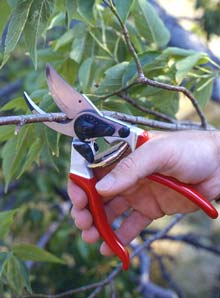
A small investment in the right tools will pay big dividends in making your gardening easier.
The heaviest, most expensive tools might not always be the best choice. They might last forever because they are too heavy to use comfortably and end up staying in the garage.
However, penny-pinching is not the answer either. Cheap tools often fail because corners are cut in the materials used or the way in which the materials are put together.
One area to inspect is the point at which the metal head meets a wooden handle. The head should not just be pounded into a hole bored in the handle or it will soon come apart. Look for a rivet or two that hold the metal head into holes drilled through the wooden handle.
Flimsy materials are frustrating. Spades that fold up when you lean your full body weight on them should be avoided. The blades of pruning shears should be heavy or they will spread apart under pressure. Compare what's available and don't buy the thinnest.
The basic tools include:
Trowel. Again, look for a heavy connection where the head meets the handle. If it is just a little strip of metal like the blade, it will fold over with use.
Sharp-pointed spade with a long handle, for turning over the soil, digging holes for landscape plants, transplanting, cleaning up after dogs, and many other jobs.
Garden rake with heavy iron teeth. Those attached to the handle by a bow that runs from either end of the head are stronger than those attached at the center of the head. This will be used for leveling off the soil after spading, cleaning up debris, marking wide rows for planting and, when flipped over on its back, pulling soil over rows of seeds.
Hoe with a six-inch-wide head, for chopping weeds, mounding earth, making furrows and, when one corner is dragged along a line, making shallow trenches for planting vegetable seeds.
Lawn or broom rake for raking leaves and other clean-up jobs. Consider spending a little more to get one with an adjustable head--wide to narrow. The narrow head is easier to get under spreading shrubs and it can also be adjusted to thin vegetable seedlings in the garden.
Anvil-type hand pruning shears. Make sure the cutting blade is heavy enough for the task. Carry it with you every time you go out to garden; you will always have a use for it.
A long-bladed knife. A kitchen reject with 10-inch blade is fine; the thinner the better. Use it to harvest lettuce, cut string, or hack off intruding grass. Slide it under weeds to pop them out.
A canvas carrying bag with a pocket is handy for toting seeds, small tools, transplants, your garden book, and other odds and ends.
Photography by National Gardening Association